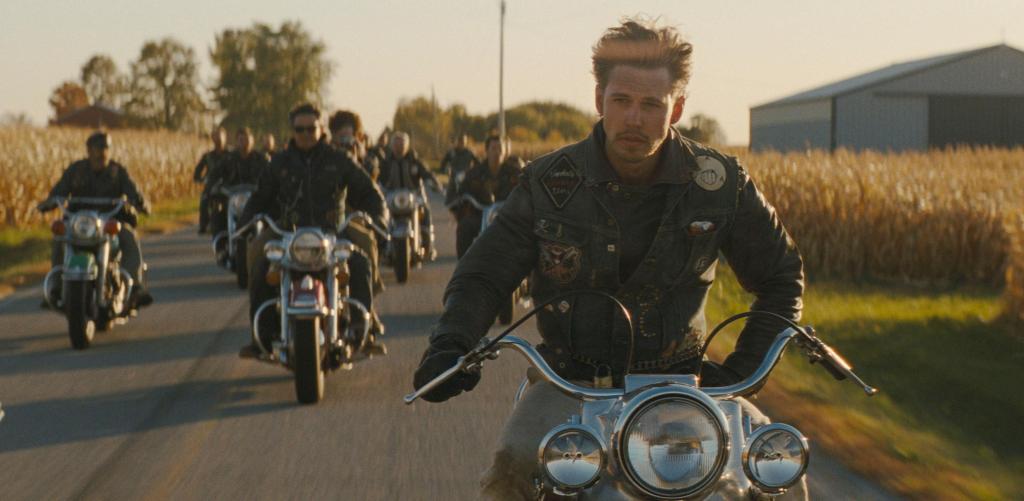Making a movie inspired by Danny Lyon’s 1968 photojournalism book “The Bikeriders” offers a filmmaker everything except a sure thing.
A one-time member of the Outlaws Motorcycle Club, founded in suburban McCook, photographer and (later) documentary filmmaker Lyon turned the aesthetic notion of Robert Frank’s “The Americans” outside in, capturing images — and in Lyon’s case, tape-recorded anecdotes converted to text accompanying the photos — not as a penetrating outsider but a watchful insider. The book remains a key collection of Chicago-area images, faces, revelry, desolation, two-lane roads and one-way fate. You can hear the engines even on the page.
From this book, working in a spirit of homage, writer-director Jeff Nichols has made a cool, absorbing feature that goes its own way.
This is Nichols’ sixth feature and his most visually fastidious, re-creating at certain points images straight from Lyon’s book. Nichols’ cinematographer Adam Stone plainly relished this assignment. The storyline won’t be enough for some audiences; it’s a hangout movie more than a propulsive, straight-line experience. Yet it lingers in the memory, raising questions about fact vs. invention, and the romance and glorification of ’60s motorcycle culture vs. the cost of all that fossil-fueled freedom.
Outlaws no more, the characters in “The Bikeriders” go by the fictional name of the Vandals, though a key handful of first-named characters carry over from real life. That starts with Kathy, the tough, perceptive wife of the most charismatic and movie-starry of the Vandals. She gives Nichols his movie’s entry point, as the Lyons stand-in (played by Mike Faist, of “Challengers”) interviews Kathy first in 1965, then a few years later, then a final time in the early ’70s.
Jodie Comer plays Kathy, in what you might call a “dialect-forward” turn with a vocal characterization based directly from Lyons’ interview recordings of the real Kathy. Is this a quintessential Chicago voice? Only someone from the Midwest would believe there is one true voice to be found here. The British actress is exceptionally deft at dialects of all kinds; if there’s anything getting in the way of Comer’s performance, which is terrific especially in her non-verbal indicators of distress and second thoughts in between the words, it’s the way Nichols uses Kathy as our reiterative tour guide into the subculture. (Too often she tells us what we’re about to see, and then comes the flashback.)
Comer’s also marvelous and committed, and she’s not alone. At this point I’d call Austin Butler, who plays Benny, more of a marvelous presence than a nimble, surprising actor, but what he’s doing in “The Bikeriders” is what Nichols’ storyline needs: a paragon of cool, torn between two people who love him.
The narrative sets up a triangle with Kathy vying for Benny’s devotion with Johnny, the Vandals club leader played by Tom Hardy. Speaking of a dialect fiend! Hardy’s heavily marbled dialect here owes everything to Marlon Brando in “The Wild One,” for a supportable-or-close-enough reason: There’s a scene where Johnny’s watching “The Wild One” on TV one late night, and he’s never the same again. He has found his image of what kind of man he wants to become.
Those who elect to leave the Vandals brotherhood rarely live long, since the rules of conduct prevent it. Benny can’t leave, he thinks, though as brutalities and injuries pile up, Kathy can’t stomach what’s happened to him, and them. That’s the chief tension element in “The Bikeriders.” Benny owes his fealty to Johnny, who’s growing older and getting tired. (Johnny’s one of the family men of the club, though we don’t see much of his wife or his kids.) As the ’60s roll on, the club expands and opens its membership to younger, less obedient outlaw wannabes, many coming home from Vietnam with messed-up wiring and terrible PTSD.
In Lyons’ book and at one point in Nichols’ movie, the distinction is drawn between the guys who got drunk and violent, and the guys who got high, often on heroin, and got really violent. The Vandals’ house parties grow increasingly sinister as the decade descends into political bloodshed, seemingly taking place on another planet.
Various supporting Vandals weave in and out of the movie, notably Nichols regular Michael Shannon, who plays a real person known as Zipco. More scenes, clearly, were shot with this ripe character and I wish more had made the final cut, but he’s spot-on. I liked the easygoing vibe provided by Damon Herriman as the loyal Brucie. Why not Brucie? Benny asks at one point, when Johnny pressures Benny to take over. He doesn’t have what it takes, he replies. “The Bikeriders” considers a narrow but indelible set of examples of what masculinity means to these lost men who have found each other. For some it was enough.
Nichols only solves so many of the riddles and challenges in adapting a photo monograph into a two-hour drama. The movie was shot mainly in Cincinnati and other parts of Ohio and you can tell, with all the hills. (Sorry, Chicago nitpicking.) There are moments when the dialect collisions get pretty wild. But there’s real texture in the acting. Nichols has yet to make an uninteresting film; this one’s a stimulating collision of myth and realism, and keeping Comer at the core was a very smart move.
“The Bikeriders” — 3 stars (out of 4)
MPA rating: R (for language throughout, violence, some drug use and brief sexuality)
Running time: 1:56
How to watch: Premieres in theaters June 21
Michael Phillips is a Tribune critic.


